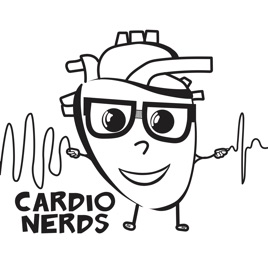
Advertise on podcast: Cardionerds: A Cardiology Podcast
Rating
4.7 from
Country
This podcast has
300 episodes
Language
Publisher
Explicit
No
Date created
2019/12/12
Average duration
-
Release period
6 days
Description
Cardionerds is a medical cardiology podcast created to bring high yield cardiovascular concepts in a fun and engaging format for listeners of all levels. We aim to democratize cardiovascular education, promote diversity & inclusion in our beloved field, empower every learner to teach & every teacher to learn and foster wellness & humanity for all. Check us out! www.cardionerds.com
Social media
Check Cardionerds: A Cardiology Podcast social media presence
Podcast episodes
Check latest episodes from Cardionerds: A Cardiology Podcast podcast
360. Obesity: Lifestyle & Pharmacologic Management of Obesity with Dr. Ambarish Pandey
2024/02/19
CardioNerds Dr. Rick Ferraro (CardioNerds Academy House Faculty and Cardiology Fellow at JHH), Dr. Gurleen Kaur (Director of the CardioNerds Internship and Internal Medicine resident at BWH), and Dr. Alli Bigeh (Cardiology Fellow at the Ohio State) as they discuss the growing obesity epidemic and how it relates to cardiovascular disease with Dr. Ambarish Pandey (Cardiologist at UT Southwestern Medical Center). Show notes were drafted by Dr. Alli Bigeh. CardioNerds Academy Intern and student Dr. Shivani Reddy performed audio editing.
Obesity is an important modifiable risk factor for cardiovascular disease, and it is on the rise! Here, we discuss how to identify patients with obesity and develop an approach to address current lifestyle recommendations. We also discuss the spectrum of pharmacologic treatment options available, management strategies, and some therapy options that are on the horizon.
This episode was produced in collaboration with the American Society of Preventive Cardiology (ASPC) with independent medical education grant support from Novo Nordisk. See below for continuing medical education credit.
Claim CME for this episode HERE.
CardioNerds Prevention PageCardioNerds Episode PageCardioNerds AcademyCardionerds Healy Honor Roll
CardioNerds Journal ClubSubscribe to The Heartbeat Newsletter!Check out CardioNerds SWAG!Become a CardioNerds Patron!
Pearls and Quotes - Lifestyle & Pharmacologic Management of Obesity
* Identify obese patients not just using BMI, but also using anthropometric measurements such as waist circumference (central adiposity).
* Lifestyle modifications are our first line of defense against obesity! Current recommendations emphasize caloric restriction of at least 500kcal/day, plant-based and Mediterranean diets, and getting at least 150 minutes of moderate-intensity weekly exercise.
* Dive into the root cause of eating and lifestyle behaviors. It is crucial to address adverse social determinants of health with patients to identify the driving behaviors, particularly among those individuals of low socioeconomic status.
* Newer weight loss agents are most effective at achieving and maintaining substantial weight loss, in particular Semaglutide (GLP-1) and Tirzepatide (GLP-1/GIP).
more
359. Case Report: Fee-Fi-Fo-Fum: An Unusual Case of Rapidly Progressive Heart Failure – Georgetown University
2024/02/12
CardioNerds join Dr. Ethan Fraser and Dr. Austin Culver from the MedStar Georgetown University Hospital internal medicine and cardiology programs in our nation’s capital. They discuss the following case involving an unusual case of rapidly progressive heart failure. Episode audio was edited by CardioNerds Academy Intern and student Dr. Pacey Wetstein. Expert commentary was provided by advanced heart failure cardiologist Dr. Richa Gupta.
A 55-year-old male comes to the clinic (and eventually into the hospital) for what appears to be a straightforward decompensation of his underlying cardiac disease. However, things aren’t as simple as they might appear. In this episode, we will discuss the outpatient workup for non-ischemic cardiomyopathy and discuss the clinical indicators that we as clinicians should be aware of in these sick patients. Furthermore, we will discuss the differential for NICM, the management of patients with this rare disease, and how this disease can mimic other cardiomyopathies.
US Cardiology Review is now the official journal of CardioNerds! Submit your manuscript here.
CardioNerds Case Reports PageCardioNerds Episode PageCardioNerds AcademyCardionerds Healy Honor Roll
CardioNerds Journal ClubSubscribe to The Heartbeat Newsletter!Check out CardioNerds SWAG!Become a CardioNerds Patron!
Case Media - Rapidly Progressive Heart Failure
Pearls - Rapidly Progressive Heart Failure
* The non-ischemic cardiomyopathy workup should incorporate targeted multimodal imaging, thorough history taking, broad laboratory testing, genetic testing if suspicion exists for a hereditary cause, and a deep understanding of which populations are at higher risk for certain disease states.
* Key Point: Always challenge and question the etiology of an unknown cardiomyopathy – do not assume an etiology based on history/patient story alone.
* Unexplained conduction disease in either a young or middle-aged individual in the setting of a known cardiomyopathy should raise suspicion for an infiltrative cardiomyopathy and set off a referral to an advanced heart failure program.
* Key Point: Consider early/more aggressive imaging for these patients and early electrophysiology referral for primary/secondary prevention.
more
358. Guidelines: 2022 AHA/ACC/HFSA Guideline for the Management of Heart Failure – Question #31 with Dr. Javed Butler
2024/02/09
The following question refers to Section 9.5 of the 2022 AHA/ACC/HFSA Guideline for the Management of Heart Failure.
The question is asked by Keck School of Medicine USC medical student & former CardioNerds Intern Hirsh Elhence, answered first by Vanderbilt Cardiology Fellow and CardioNerds Academy Faculty Dr. Breana Hansen, and then by expert faculty Dr. Javed Butler.
Dr. Butler is an advanced heart failure and transplant cardiologist, President of the Baylor Scott and White Research Institute, Senior Vice President for the Baylor Scott and White Health, and Distinguished Professor of Medicine at the University of Mississippi
The Decipher the Guidelines: 2022 AHA / ACC / HFSA Guideline for The Management of Heart Failure series was developed by the CardioNerds and created in collaboration with the American Heart Association and the Heart Failure Society of America. It was created by 30 trainees spanning college through advanced fellowship under the leadership of CardioNerds Cofounders Dr. Amit Goyal and Dr. Dan Ambinder, with mentorship from Dr. Anu Lala, Dr. Robert Mentz, and Dr. Nancy Sweitzer. We thank Dr. Judy Bezanson and Dr. Elliott Antman for tremendous guidance.
Enjoy this Circulation 2022 Paths to Discovery article to learn about the CardioNerds story, mission, and values.
Question #31
Mrs. Hart is a 70-year-old woman who was admitted to the CICU two days ago for signs and symptoms consistent with cardiogenic shock. Since her admission, she has been on maximal diuretics, requiring greater doses of intravenous dobutamine. Unfortunately, her liver and renal function continue to worsen, and urine output is decreasing. A right heart catheterization reveals elevated biventricular filling pressures with a cardiac index of 1.7 L/min/m2 by the Fick method.
What is the next best step?
more
357. CardioOncology: Cardiac Tumors with Dr. Juan Lopez-Mattei
2024/02/08
CardioNerds co-founder Dr. Dan Ambinder, series chair Dr. Teodora Donisan, and Dr. Sukriti Banthiya discuss cardiac tumors with Dr. Juan Lopez-Mattei, a nationally recognized expert in the fields of cardio-oncology and the director of cardiac imaging at the Lee Health Heart Institute. Here, we explore the topic of cardiac tumors, with a focus on distinguishing between primary and secondary tumors. We delve into the symptoms, diagnostic methods, and treatment options. Show notes were drafted by Dr. Sukriti Banthiya and episode audio was edited by CardioNerds Intern and student Dr. Diane Masket.
This episode is supported by a grant from Pfizer Inc.
This CardioNerds Cardio-Oncology series is a multi-institutional collaboration made possible by contributions of stellar fellow leads and expert faculty from several programs, led by series co-chairs, Dr. Giselle Suero Abreu, Dr. Dinu Balanescu, and Dr. Teodora Donisan.
CardioNerds Cardio-Oncology PageCardioNerds Episode PageCardioNerds AcademyCardionerds Healy Honor Roll
CardioNerds Journal ClubSubscribe to The Heartbeat Newsletter!Check out CardioNerds SWAG!Become a CardioNerds Patron!
Pearls and Quotes - Cardiac Tumors
* Keep it simple when approaching an intracardiac mass; start with transthoracic echocardiography (TTE) and use transesophageal echocardiography (TEE) or cardiac magnetic resonance (CMR) based on the clinical context. Use TEE when suspecting valvular vegetations or thrombi & CMR for intracavitary cardiac masses.
* Cardiac tumors can manifest with a variety of symptoms; however, they are more commonly diagnosed as an incidental finding!
* When faced with the dilemma of selecting the most suitable imaging modality for evaluating a cardiac mass, consider the following hierarchy: begin with TTE as the first choice, followed by CMR. If the patient cannot undergo CMR, the next step is cardiac computed tomography (CT) or Fluorodeoxyglucose F18 positron emission tomography...
more
356. 2023 ACC/AHA/ACCP/HRS Atrial Fibrillation Guidelines – Key Takeaways with Dr. José Joglar and Dr. Mina Chung
2024/01/23
CardioNerds Atrial Fibrillation Series Co-Chairs Dr. Colin Blumenthal (University of Pennsylvania Cardiology fellow) and Dr. Kelly Arps (Duke University Electrophysiology Fellow) join the 2023 atrial fibrillation guideline writing committee Chair Dr. José Joglar (UT Southwestern) and Vice Chair Dr. Mina Chung (Cleveland Clinic). They review the key takeaways from the 2023 ACC/AHA/ACCP/HRS Guideline for the Diagnosis and Management of Atrial Fibrillation. Audio editing by CardioNerds academy intern, student doctor Pace Wetstein.
This podcast was developed in collaboration with the American Heart Association. For more on these guidelines, access the AHA Science News AF Guideline landing page.
CardioNerds Atrial Fibrillation PageCardioNerds Episode PageCardioNerds AcademyCardionerds Healy Honor Roll
CardioNerds Journal ClubSubscribe to The Heartbeat Newsletter!Check out CardioNerds SWAG!Become a CardioNerds Patron!
more
355. Case Report: Hypertension With a Twist – Mount Sinai Medical Center
2024/01/16
CardioNerds nerd out with Drs. Karishma Rahman (Mount Siani Vascular Medicine fellow), Shu Min Lao (Mount Sinai Rheumatology fellow), and Constantine Troupes (Mount Sinai Vascular Surgery fellow). They discuss the following case: A 20-year-old woman with a history of hypertension (HTN), initially thought to be secondary to a mid-aortic syndrome that resolved after aortic stenting, presents with a re-occurrence of HTN. The case will go through the differential diagnosis of early onset HTN focusing on structural etiologies of HTN, including mid-aortic syndrome and aortitis. We will also discuss the multi-modality imaging used for diagnosis and surveillance, indications and types of procedural intervention, and how to diagnose and treat an underlying inflammatory disorder leading to aortitis. The expert commentary was provided by Dr. Daniella Kadian-Dodov, Associate Professor of Medicine and Vascular Medicine specialist at the Icahn School of Medicine at Mount Sinai. Audo editing was performed by Dr. Chelsea Amo-Tweneboah, CardioNerds Academy Intern and medicine resident at Stony Brook University Hospital.
US Cardiology Review is now the official journal of CardioNerds! Submit your manuscript here.
CardioNerds Case Reports PageCardioNerds Episode PageCardioNerds AcademyCardionerds Healy Honor Roll
CardioNerds Journal ClubSubscribe to The Heartbeat Newsletter!Check out CardioNerds SWAG!Become a CardioNerds Patron!
Case Media - Hypertension With a Twist
Pearls - Hypertension With a Twist
* Early onset hypertension (HTN) and lower extremity claudication should raise suspicion for aortic stenosis (including mid-aortic syndrome). Initial evaluation should include arterial duplex ultrasound and cross-sectional imaging such as CT or MR angiogram of the chest, abdomen, and pelvis to assess for arterial stenosis involving the aorta and/or branching vessels.
* Mid-aortic syndrome can have multiple underlying etiologies. Concentric aortic wall thickening should raise suspicion for an underlying inflammatory disorder. Initial evaluation should include inflammatory markers such as ESR, CRP, and IL-6, but normal values do not exclude underlying aortitis.
more
354. Obesity: Obesity & Cardiovascular Disease Risk with Dr. Jaime Almandoz
2024/01/09
CardioNerds Dr. Rick Ferraro (cardiology fellow at Johns Hopkins Hospital) and Dr. Eunice Dugan (cardiology fellow at the Cleveland Clinic) join episode lead Dr. Tiffany Brazile (cardiology fellow at the University of Texas Southwestern Medical Center and postdoctoral fellow at the Institute for Exercise and Environmental Medicine) to discuss the impact of obesity on cardiovascular disease risk, differential risk in specific populations, and effective strategies for counseling patients. They are joined by expert Dr. Jaime Almandoz, Medical Director of the Weight Wellness Program and an Associate Professor of Medicine at the University of Texas Southwestern Medical Center. Audio editing was performed by CardioNerds Academy Intern, student Dr. Tina Reddy.
This episode was produced in collaboration with the American Society of Preventive Cardiology (ASPC) with independent medical education grant support from Novo Nordisk. See below for continuing medical education credit.
Claim CME for this episode HERE.
CardioNerds Prevention PageCardioNerds Episode PageCardioNerds AcademyCardionerds Healy Honor Roll
CardioNerds Journal ClubSubscribe to The Heartbeat Newsletter!Check out CardioNerds SWAG!Become a CardioNerds Patron!
Pearls and Quotes - Obesity & Cardiovascular Disease Risk
* The durability of metabolically healthy obesity (i.e., normal A1c, lipids, LFTs, BMP, normotensive) is limited. Within 5 years, a third of adults with “metabolically healthy” obesity will develop a cardiometabolic complication.
* The biomechanical and psychosocial complications of obesity are just as important as the cardiometabolic complications. Biomechanical and psychosocial complications, including obstructive sleep apnea, joint pain, and mood disorders also influence cardiovascular disease risk.
* Weight loss is not always the patient’s goal. Meet patients where they are and understand their challenges, concerns, and long-term goals with respect to their cardiovascular health and obesity. This information provides an opportunity to frame the conversation in a supportive and engaging way that allows for patient education.
* Body mass index (BMI) is a screening tool for obesity, but is not sufficient for providing individualized care.
more
353. Atrial Fibrillation: Anticoagulation Pharmacology & Clinical Decision-Making with Dr. Ashley Lochman and Dr. Chris Domenico
2023/12/29
CardioNerds co-founder Dr. Amit Goyal, series co-chair Dr. Colin Blumenthal, and episode lead Dr. Anushka Tandon to discuss pharmacologic anticoagulation options in atrial fibrillation with Drs. Ashley Lochman and Chris Domenico. The case-based review helps clarify some key concepts, such as when warfarin is preferred for anticoagulation, who may be a good DOAC (direct-acting oral anticoagulant) candidate, how to choose an appropriate DOAC agent, and how to manage anticoagulation therapy in patients already on antiplatelet therapies. Notes were drafted by Dr. Anushka Tandon. The episode audio was edited by student Dr. Shivani Reddy.
This CardioNerds Atrial Fibrillation series is a multi-institutional collaboration made possible by contributions of stellar fellow leads and expert faculty from several programs, led by series co-chairs, Dr. Kelly Arps and Dr. Colin Blumenthal.
This episode was planned and recorded prior to the release of the 2023 ACC/AHA/ACCP/HRS Guideline for the Diagnosis and Management of Atrial Fibrillation. Please refer to this guideline document for the most updated recommendations.
We have collaborated with VCU Health to provide CME. Claim free CME here!
CardioNerds Atrial Fibrillation PageCardioNerds Episode PageCardioNerds AcademyCardionerds Healy Honor Roll
CardioNerds Journal ClubSubscribe to The Heartbeat Newsletter!Check out CardioNerds SWAG!Become a CardioNerds Patron!
Pearls and Quotes - Anticoagulation Pharmacology
* Avoid potentially fatal errors with this terminology tip for correctly referencing non-warfarin oral anticoagulant agents: it’s DOAC (like, please DO use AntiCoagulation), not NOAC (imagine someone interpreting that as “NO AntiCoagulation for this patient” at discharge – yikes)!
* Sometimes, an oldie really is a goodie – warfarin is recommended over DOACs for patients with mechanical heart valves, moderate-to-severe mitral stenosis, anti-phospholipid antibody syndrome (APLS), left ventricular (LV) thrombus, higher INR goals, or DOAC failure. Patient preference and medication costs should also be considered – at the end of the day,
more
352. Case Report: The Culprit in the Pillbox – University of Kansas
2023/12/27
CardioNerds (Dr. Amit Goyal) join Dr. Anureet Malhotra, Dr. John Fritzlen, and Dr. Tarun Dalia from the University of Kansas School of Medicine for some of Kansas City’s famous barbeque. They discuss a case of Hydroxychloroquine induced cardiomyopathy. Notes were drafted by Dr. Anureet Malhotra, Dr. John Fritzlen, and Dr. Tarun Dalia. Expert commentary was provided by Dr. Pradeep Mammen. The episode audio was edited by Dr. Akiva Rosenzveig.
Drug-induced cardiomyopathy remains an important and under-recognized etiology of cardiomyopathy and heart failure. Hydroxychloroquine is a disease-modifying antirheumatic drug used for various rheumatological conditions, and its long-term use is well-known to have toxic effects on cardiac muscle cells. Multiple cardiac manifestations of these drugs have been identified, the most prominent being electrophysiological disturbances.
In this episode, we discuss a biopsy-proven case of hydroxychloroquine-induced cardiotoxicity with detailed histopathological and imaging findings. We develop a roadmap for the diagnosis of hydroxychloroquine-induced cardiomyopathy and discuss the various differentials of drug-induced cardiomyopathy. We highlight the importance of clinical monitoring and early consideration of drug-induced toxicities as a culprit for heart failure.
US Cardiology Review is now the official journal of CardioNerds! Submit your manuscript here.
CardioNerds Case Reports PageCardioNerds Episode PageCardioNerds AcademyCardionerds Healy Honor Roll
CardioNerds Journal ClubSubscribe to The Heartbeat Newsletter!Check out CardioNerds SWAG!Become a CardioNerds Patron!
Case Media - Hydroxychloroquine induced cardiomyopathy
Pearls - Hydroxychloroquine induced cardiomyopathy
* Continued decline in left ventricular systolic function despite appropriate guideline directed medical therapy should prompt a thorough evaluation for unrecognized etiologies and warrants an early referral to advanced heart failure specialists.
* Transthoracic echocardiogram is a valuable non-invasive screening tool for suspected pulmonary hypertension, but right heart catheterization is required for definitive diagnosis.
* Cardiac MRI can be used for better characterization of myocardial ti...
more
351. Case Report: The Tall Tail Heart: Angioleiomyoma – The Christ Hospital
2023/12/20
CardioNerds meet with fellows from The Christ Hospital, Drs. Hanad Bashir, Hyunsoo Chung, and Dalia Aziz to discuss the following case that highlights angioleiomyoma:
A 60-year-old woman with a past medical history significant for breast cancer (on tamoxifen) presented as a transfer to our facility for a clot-in-transit. She had initially presented to the outside hospital after progressive dyspnea on exertion and recent syncope. She was found on an echocardiogram to have a right atrial mass spanning into the right ventricle. CTA of the chest and abdomen/pelvis demonstrated extensive thrombus burden spanning from the IVC into the right ventricle. She was transferred to our facility for intervention.
Endovascular attempts were unsuccessful, at which point she underwent surgical thrombectomy. Gross examination of the mass revealed a cylindrical shape, homogeneous tan color, rubbery soft tissue, measuring 25.5 cm in length and 2.3 cm in diameter. Histology confirmed the presence of angioleiomyoma. A second, smaller mass (5.2cm long and 4mm in diameter) was removed from under the tricuspid valve, with histology consistent with leiomyoma. Estrogen receptor and progesterone receptor staining were strongly positive, leading to the discontinuation of tamoxifen. Given the presence of uterine fibroids identified on the CT scan, there was concern about a uterine origin. A hysterectomy is planned for her in the near future.
Expert commentary is provided by Dr. Wojciech Mazur. Episode audio was edited by student Dr. Adriana Mares.
US Cardiology Review is now the official journal of CardioNerds! Submit your manuscript here.
CardioNerds Case Reports PageCardioNerds Episode PageCardioNerds AcademyCardionerds Healy Honor Roll
CardioNerds Journal ClubSubscribe to The Heartbeat Newsletter!Check out CardioNerds SWAG!Become a CardioNerds Patron!
Case Media - The Tall Tail Heart: Angioleiomyoma – The Christ Hospital
Pearls - The Tall Tail Heart: Angioleiomyoma – The Christ Hospital
* Although evaluation of cardiac mass by echocardiography can provide information such as size, location, and morphology, adjunctive cross-sectional imaging may be used depending on the need for ...
more
350. GLP-1 Agonists: Mechanisms to Applications with Dr. Dennis Bruemmer
2023/12/19
Calling all those with a passion for cardiovascular prevention! In this episode of the CardioNerds Cardiovascular Prevention Series, we take a deep dive into the world of glucagon-like peptide-1 (GLP-1) receptor agonists. Along the way, you’ll hear about the biology of the GLP-1 molecule and its related peptides, learn more about how GLP-1 agonists promote glycemic control, weight loss, and cardiometabolic health, and explore the current body of literature supporting the individualized application of these medications to patients with diabetes, obesity, and/or ASCVD.
Join Dr. Christian Faaborg-Andersen (CardioNerds Academy Fellow and Internal Medicine Resident at MGH), Dr. Gurleen Kaur (Director of the CardioNerds Internship, Chief of House Einthoven, and Internal Medicine resident at BWH), and Dr. Rick Ferraro (CardioNerds Academy House Faculty and Cardiology Fellow at JHH) for a wide-ranging discussion on GLP-1 and GIP agonists with Dr. Dennis Bruemmer (Cardiologist and Director of the Center for Cardiometabolic Health in the section of Preventive Cardiology at the Cleveland Clinic).
Show notes were drafted by Dr. Christian Faaborg-Andersen. Audio editing was performed by CardioNerds Academy Intern, student Dr. Tina Reddy.
This episode was produced in collaboration with the American Society of Preventive Cardiology (ASPC) with independent medical education grant support from Novo Nordisk. See below for continuing medical education credit.
Claim CME for this episode HERE.
CardioNerds Prevention PageCardioNerds Episode PageCardioNerds AcademyCardionerds Healy Honor Roll
CardioNerds Journal ClubSubscribe to The Heartbeat Newsletter!Check out CardioNerds SWAG!Become a CardioNerds Patron!
Pearls and Quotes - GLP-1 Agonists: Mechanisms to Applications
* The selection and dosing of GLP-1 and GIP agonists (GLP-1s and GIPs) depends on their intended use as an anti-glycemic or anti-obesity agent.
* The cardiovascular benefits of GLP-1s and GIPs may be independent of improvements in glycemic control, and in part be driven by reduction in inflammation, a key driver of arterial plaque formation.
* In patients with comorbid coronary artery disease, obesity, and diabetes, GLP-1 agonists and SGLT-2 inhibitors should be used as first-line agents, over metformin.
more
349. Case Report: Into the Thick of It – An Unusual Cause of Hypertrophic Cardiomyopathy – Cleveland Clinic
2023/12/17
CardioNerds cofounder Dr. Amit Goyal and cardiology fellows from the Cleveland Clinic (Drs. Alejandro Duran Crane, Gary Parizher, and Simrat Kaur) discuss the following case: A 61-year-old man presented with symptoms of heart failure and left ventricular hypertrophy. He was given a diagnosis of obstructive hypertrophic cardiomyopathy. He eventually underwent septal myectomy, mitral valve replacement, aortic aneurysm repair, and aortic valve replacement with findings of Fabry’s disease on surgical pathology. The case discussion focuses on the differential diagnosis for LVH and covers Fabry disease as an HCM mimic. Expert commentary was provided by Dr. Angelika Ewrin. The episode audio was edited by student Dr. Diane Masket.
US Cardiology Review is now the official journal of CardioNerds! Submit your manuscript here.
CardioNerds Case Reports PageCardioNerds Episode PageCardioNerds AcademyCardionerds Healy Honor Roll
CardioNerds Journal ClubSubscribe to The Heartbeat Newsletter!Check out CardioNerds SWAG!Become a CardioNerds Patron!
Case Media - An Unusual Cause of Hypertrophic Cardiomyopathy – Cleveland Clinic
Pearls - An Unusual Cause of Hypertrophic Cardiomyopathy – Cleveland Clinic
* Left ventricular hypertrophy is a cardiac manifestation of several different systemic and cardiac processes, and its etiology should be clarified to avoid missed diagnosis and treatment opportunities.
* Fabry disease is a rare, X-linked inherited disease that can present cardiac and extra-cardiac manifestations, the former of which include hypertrophic cardiomyopathy, conduction defects, coronary artery disease, conduction abnormalities, arrhythmias, and heart failure.
* The diagnosis of Fabry disease includes measurement of alpha-galactosidase enzyme activity as well as genetic testing to evaluate for pathogenic variants or variants of unknown significance in the GLA gene. Family members of patients diagnosed with Fabry diseas...
more
Podcast reviews
Read Cardionerds: A Cardiology Podcast podcast reviews
Andreinavalenzuela
2024/01/09
-NP student
Great content and use of case studies! The patient-centered approach is always appreciated. The speakers have very diverse backgrounds and deliver up ...
more
Rixtergirl
2023/08/25
Solid show - amazing faculty and guest experts!
Too notch discussions. Really informative !!!
Cam Mattes
2023/11/01
CT surgery APN
It would be MUCH better without the lengthy introductions and strange, seemingly scripted banter that said the content is great. But..we get it. You’r...
more
golgikanji
2023/10/18
Dr Cullen and endocarditis.
Great show! Very useful information presented perfectly. Strong work. However, too bad you chose such a demeaning name for your show. It promotes the...
more
leah PFQHC
2021/10/25
Fantastic review even for PCPs
I’m a family doc at an FQHC and take care of a lot of patients with heart disease. I just discovered this podcast and find it super useful even for a ...
more
D_Edwards16
2022/08/04
Ok
If you didn’t know, they work at the Cleveland clinic.
Dave K EP
2022/05/07
Awesome podcast
Amazing podcast overall. The content is awesome. However, I’m not a fan of the excessive praises before and after every comment, it sounds fake, like ...
more
alysssamaria
2021/05/27
Amazing podcast
I work as a cardiac ICU nurse & I love listening to the case reports. I always learn something new!
NewHollander
2021/09/04
Curbsiders brought me here
FM here. Great stuff docs! Entertaining and educational. However, I think cutting down on the awkward and overly effusive praise that follows every si...
more
Greg Potter
2021/06/14
Dr. Martha Gulati is an idiot.
Dr. Martha Gulati is an idiot.
Podcast sponsorship advertising
Start advertising on Cardionerds: A Cardiology Podcast & sponsor relevant audience podcasts
You may also like these medicine Podcasts

4.8
1120
208
Psychiatry & Psychotherapy Podcast
David Puder, M.D.

4.6
231
104
Psychopharmacology and Psychiatry Updates
Psychopharmacology Institute

5
87
38
Born to Heal: Holistic Healing for Optimal Health
Dr. Katie Deming, M.D. | Conscious Oncologist

4.6
157
1099
Pharmacy Podcast Network
Pharmacy Podcast Network

4.5
412
353
JAMA Clinical Reviews
JAMA Network

4.9
497
41
The Nurse Blake Podcast
Nurse Blake
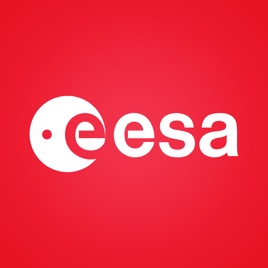
5
2
44
ESA Explores
European Space Agency
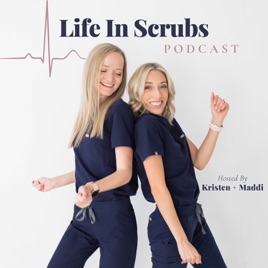
4.9
129
66
Life In Scrubs
Life In Scrubs
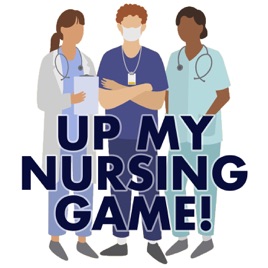
4.8
145
70
Up My Nursing Game
Annie
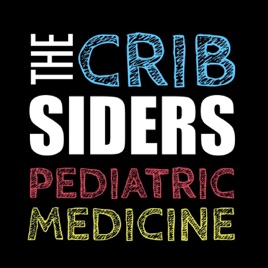
4.8
271
111
The Cribsiders
The Cribsiders



